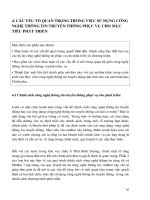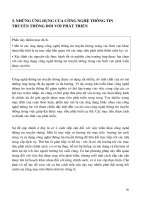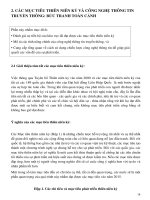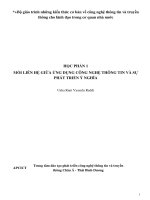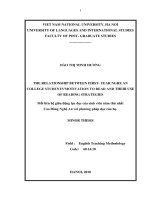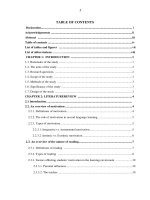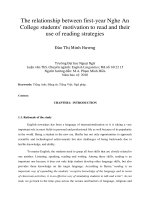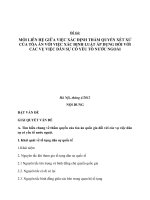The relationship between first-year Nghe An College students' motivation to read and their use of reading strategies = Mối liên hệ giữa động lực đọc của sinh vi20150227
Bạn đang xem bản rút gọn của tài liệu. Xem và tải ngay bản đầy đủ của tài liệu tại đây (436.99 KB, 52 trang )
5
TABLE OF CONTENTS
Declaration i
Acknowledgements ii
Abstract iii
Table of contents iv
List of tables and figures vii
List of abbreviations ……………………………………………………………………viii
CHAPTER 1: INTRODUCTION 1
1.1 Rationales of the study 1
1.2. The aims of the study 2
1.3. Research questions 2
1.4. Scope of the study 3
1.5. Methods of the study 3
1.6. Significance of the study 3
1.7. Design of the study 3
CHAPTER 2: LITERATUREREVIEW 4
2.1 Introduction
2.2. An overview of motivation 4
2.2.1. Definitions of motivation. 4
2.2.2. The role of motivation in second language learning 5
. 2.2.3. Types of motivation 5
2.2.3.1. Integrative vs. instrumental motivation 5
2.2.3.2. Intrinsic vs. Extrinsic motivation 6
2.3. An overview of the nature of reading 7
2.3.1. Definitions of reading 7
2.3.2. Types of reading 8
2.3.3. Factors affecting students‟ motivation in the learning enviroment 10
2.3.3.1. Parental influences 10
2.3.3.2. The teacher 10
6
2.3.3.3. The reading texts 11
2.3.3.4 Feedback 13
2.4. Motivation in reading 13
2.4.1 The importance of motivation in reading 13
2.4.2. The role of the teacher and the students in teaching and learning Reading. 13
2.4.2.1 The role of the teacher 13
2.4.2.2. The role of the students 14
2.5. Reading Comprehension Strategies 15
2.5.1. What is a Teaching Strategy? 15
2.5.2. Nature of Reading Comprehension Strategies 15
2.5.2.1. Key Features, Communicative Competence as the Major Goal
and Greater Self-Direction for Readers 15
2.5.2.2. Other Features of the Nature of Reading Comprehension Strategies 17
2.6 .The relationship between Motivation and the use of reading strategies 18
CHAPTER 3: METHODOLOGY 19
3.1. Introduction 19
3.2. Setting of the study 19
3.3. Participants 19
3.4. Instruments data collection 20
3.5. Data collection procedures 20
3.5.1 Demographic information 20
3.5. 2. Analytical procedures 21
CHAPTER 4: FINDINGS, DISCUSSIONS AND RECOMMENDATIONS 23
4.1. Introduction 23
4.2. Findings and discussions. 23
7
4.2.1. Results from teacher‟s survey questionnaire (see Appendix 2) 23
4.2.1.1 Teacher„s personal information 23
4.2.1.2 Teacher‟s opinions towards students‟ motivation 23
4.2.2. Results from students‟ survey motivation 27
4.2.2.1. Types of students‟ motivation in learning reading 27
4.2.2.2. Factors affecting students‟ motivation in learning reading 28
4.2.3. Results of the relationship between motivation and reading strategies: 28
4.3. Recommendations 30
4.3.1 The teachers 30
4.3.1.1. Improving the teacher‟s roles 30
4.3.1.2. “Top ten” principles for teaching reading(Adapting by Ray Williams) 32
4.3.1.3.Basic principles of motivation exist that are applicable to learning in any
situation (Adapting by Matthew Weller, Los Angeles Business Journal, March 14,
2005): 34
4.3.2. The students 35
4.3.2.1. The role of reading skill to the students‟ learning English and future career 35
4.3.2.2. The role of reading materials to the motivation for learning reading skill 36
4.3.2.3 The students‟comments on their current reading lessons 36
CHAPTER 5 : CONCLUSION 38
5.1 Conclusions 38
5.2. Limitations and suggestions for further study 38
REFERENCES 40
APPENDIXES
Appendix 1: Survey questionnaire for teachers
Appendix 2: Survey questionnaire for students
8
LIST OF ABBREVIATIONS
NJTTC : Nghe An Junior Teachers Training College
SPSS : Statistical Package for Social Science (SPSS Software for MS Window Release
10.0)
TALO Text a linguistic object
TAVI Text as vehicle for information
PQ4R Preview, Question, Read, Recite, Reflect, and Review
9
LIST OF TABLES AND FIGURES
Figure 1: Respondents by gender
Figure 2: Respondents by age
Figure 3: Techniques to motivate
Table 1. Teacher‟s opinions on student‟s motivation of the reading stages
Table 2. Problems teachers facing in teaching reading
Table 3. Activities applied by teachers by frequency
Table 4: The necessary reading skill to enhance reading ability in the view of the teachers
Table 5: The distribution of the freshmen‟s reasons for learning reading
Table 6: Factors affecting students‟ motivation in reading
Table 7: Relationship between motivation and reading strategies
Table 8: Relationship between motivation and reading strategies
10
CHAPTER1: INTRODUCTION
1.1. Rationale of the study
English nowadays has been a language of internationalization so it is taking a very
important role in most fields in personal and professional life as well because of its
popularity in the world. Being a student in the new era. She/he has not only opportunities
to approach scientific and technological achievements but also challenges of being
backwards due to her/his knowledge, and ability.
To master English, the students need to grasp all four skills that are closely related
to one another: Listening, speaking, reading and writing. Among these skills, reading is an
important one because it does not only help student develop other language skills, but also
provides them knowledge on the target language. According to Byrne,“reading is an
important way of expanding the students’ receptive knowledge of the language and in
terms of classroom activities, it is an effective way of simulating students to talk and
write”. As we read, we go back to the time, pass across the oceans and barriers of
language, religions and cultures. Through reading, we can escape into the mind of a
philosopher, observe with a scientist, stay with scholar, analyze with a critic and live
through a novel or a play.
Reading is one of the most important skills in learning English. Being a teacher of
English at Nghe An college, I realized that most of students face many problems in
learning reading. This is due to the fact that reading lesson is so boring that student often
feel tired and stressed. Students often experience the lack of reading strategies which are
essential for them to overcome the challenges in the classroom so motivation is one of the
key factors that determine student ‟success or failure in language learning. One of the
major concerns of educators and parents is motivating students so that they work at the
best of their abilities ( Guthrie, Solomon 1997). The key is to motivate them in such a way
that they want to do the task that we are assigning .For this reason, I decided on choosing
“The relationship between first –year Nghe An college students’ motivation to read and
their use of reading strategies”
1.2. Aims of the study
* To identify types of motivation possessed by the first-year-college students in
learning reading
11
* To investigate some factors affecting students' motivation in learning reading.
* The major purpose of this study is to find out whether there is any relationship
between motivation and use of reading strategies and which type of motivation will
influence students' choice of reading strategies.
1.3. The research questions
1. What are the types of motivation possessed by the first -year -students in reading
learning?
2. Is there a relationship between the types of motivation (integrative motivation
and instrumental motivation) and learners' choice of reading strategies?
3. What are the factors affecting students' motivation in learning reading?
1.4. Scope of the study
Motivation is one of the factors that may maintain a strong influence on the way
language learners use learning strategies. This study, however, is designed to investigate
the relationship between students' motivation to read and their use of reading strategies.
Besides, the sample of the study was drawn from the first –year- students at the
Department of English, NGHE AN college.
1.5. Methods of the study.
To achieve the aims mentioned above, data were collected through the survey
questionnaire.
The quantitative research method is used with the aim of obtaining information on
students‟ motivation when they learn reading to find out the relationship between students‟
motivation to read and their use of reading strategies.
1.6. Significance of the study
Motivation is one of the key issues in language learning and it has long been
believed to have a good impact on success or failure of a language learners.The study is
significant for the following reason:
It studies types of motivation which are possessed by most of the students in
English Department, Nghe An college
It investigates a relationship between the types of motivation (integrative and
instrumental motivation) and learners' choice of reading strategies.
It points out some suggestions for the teachers to improve the textbook, and some
techniques to help motivate learners.
12
1.7. Design of the study
The study consists of three main parts: the introduction, the development and the
conclusion.
Chapter 1 introduces rationale, aims of the study, the research questions as well as
scope, significance of the study and methods of the study.
Chapter 2 deals with an overview of the theoretical background of the research. It
is concerned with the issues relevant to the topic of the research motivation and reading
strategies, classification of the reading, motivation in reading, the importance of motivation
in reading, factors affecting students‟ motivation in the learning environment, the role of
the teacher and the students in teaching and learning, reading comprehension strategies, the
relationship between motivation and the use of reading strategies.
Chapter 3 presents the method used in the study including situation analysis,
instruments and the procedure of data analysis and shows the detailed results together with
a comprehensive analysis on the data collected from the survey questionnaires
Chapter 4 gives some major findings, discussions of finding, and
recommendations to reading motivation activities and techniques employed by the teachers
at NJTTC, strategies for developing reading skill to first -year -students at Nghe An
college
Chapter 5, the last chapter of the study, is the conclusion where all the main
contents of the study are summarized and limitations of the study and suggestions for
further studies are presented.
13
CHAPTER 2: LITERATURE REVIEW
2.1. Introduction
This chapter is concerned with some of the most important issues in the theories of
motivation for learning reading and the use of reading strategies. Two main features will
be taken into consideration, namely, theoretical backgrounds of motivation and theoretical
background of reading strategies.
2.2. An overview of motivation
2.2.1. Definitions of motivation
Most teachers consider motivation essential for successful language learning.
Motivation is one of the factor that may influence strongly on the way language learning
use learning strategies
A number of cognitive psychological view points offer quite a different perspective
on motivation.
Brown (1993: 152) defines it as “commonly thought of as an inner drive, impulse
emotion, or desire that moves one toward or particular action"
Some psychologists claim that motivation terms of the construct of motivation
from basic innate drives. David Ausubel (1968: 368 – 379) pointed out six different drives:
Exploration
Manipulation
Activity
Stimulation
Knowledge
Ego enhancement
Motivation is one affective component that is influences by instruction. Motivation
is a function of students‟ perception of the value of information ( Mc Combs 1996 ).
Wittrock (1986) claimed that motivation as the process of initiating, sustaining and
directing activity.
According to Little wood,W.(1998) pointed out the complex phenomenon of
motivation from many different components
In second language learning as in every other field of human learning, motivation
is the crucial force which determines whether a learner embarks on a task at all, how
14
much energy he devotes to it and how long he perceives. It is a complex phenomenon and
includes many components the individual drive, need for achievement and success,
curiosity, desire for stimulation and new experience and so on (1998: 53)
Mean while, the working committee on motivation in foreign language learning at
the North East Conference of 1970 defines Motivation
…a force or incentive within a person, that person’s needs, ideas, organic state and
emotions
… the process of providing wits a motive or motives, the stimulation and
maintenance of an active interest in foreign languages (North aEast Conference report
1970.34)
2.2.2. The role of motivation in second language learning.
Motivation is a key factor is successful language learning. Oxford and Shearin
(1996: 121-122) stated that: “Motivation is important because it directly influences how
often students use second language learning strategies how much students interact wits
native speakers, how much input they receive in the language being learned, how well they
do on curriculum – related achievement tests, how high their general proficiency level
becomes, and how long they preserve and maintain second language skills often language
study is over " therefore motivation is crucial for second language learning.
Attitude and motivation have often cited by language learning theorists as well as
practicing language teachers to account for varvation in attainment anong individual
learning a second lang. So, Ramage (1990) pointed out the predictability of motivational
and attitudinal factors in the continuation of foreign language study beyond the second
years.
Accoding to Caroll (1962) motivation decides the amount of time a learner will
spend on the task of language learning. She started “the more motivation a learner has, the
more time he or she will spend learning an aspect of a second language” ( Carol 1962)
Motivation is one affective component that is influenced by instruction. Motivation
is a function of student's perceptions of the value of information ( Mc Combs,1996)
To conclude, motivation plays an important role in teaching and baining, the
teacher should know strategies to boost students‟ motive and to obtain success in teaching.
2.2.3. Types of motivation
2.2.3.1. Integrative vs. instrumental motivation
15
Motivation is an important factor in learning strategies. It‟s necessary to identify
the types of motivation that help assist in the successful acquisition of a second language.
There are 2 types of motivation – integrative motivation and instrumental motivation.
* Integrative motivation
According to Gardner,R and Lam bert ,W(1972:82) “ An integrative orientation
involves an interest in learning an because of a sincere and personal interest in the people
and culture represented by the other language group”
Integrative motivation is a major factor that promotes the learner to develop that
language to operate socially in that society.
Finegan (1999:568) pointed out "integrative motivation typically underlines
successful acquisition of a wide range of registers and a native –like pronunciation"
* Instrumental motivation
In contrast to integrative motivation, instrumental motivation is known by the
desire to gain something practical or concrete from the study of a foreign language. Ellis
(1994) claimed "some functional reason such as to pass an examination, to get a better job
or to get a university place motivate learners to learn an L2 because it opens up
educational and economic opportunities for them (1994:75)
2.2.3.2 Intrinsic vs. Extrinsic motivation
Motivation is said to be intrinsic or extrinsic
* Intrinsic motivation:
Intrinsic motivation is what learners bring to the learning motivation
Intrinsic motivation is known that the students wish to complete the task because
they are interested refers to :motivation to engage in an activity for its own sake”
(Woldkowski,1991). He means that activity itself is our benefit, so we do not need any
other kinds of rewards or punishment. He states that intrinsic motivation “is the natural
tendency to seek out and conquer challenges as we pursue personal interests and exercise
capabilities”. The factors of support of intrinsic motivation: competence (feeling that you
know how to do things), autonomy (being able to perform an activity by yourself without
external help) and relatedness ( connection with your social environment like helping the
others).
16
* Extrinsic motivation:
Harmer (2001:51) gives easily understandable definition that extrinsic motivation
“is caused by any number of outside factors such as: the nedd to pass an exam, the hope of
financial reward or the possibility of future travel”.
Most writers agree that intrinsic and extrinsic interact with each other and play an
important role in language learning. As a result, learners can be either motivated by
internal or external factors depending on the circumstances and conditions under which the
activity is performed.
Strategies to encourage students‟ motivation
2.3. An overview of the nature of reading
2.3.1 Definitions of reading
No one else reads exactly as we do. In some ways, reading is a very personal
activity which takes place in all different ways from reading newspapers, magazines,
written tests, telephone directory, labels on medicine bottles, notices, ect. The ability to
read is such a natural part of human beings that they seldom try to define reading. However
there are still different points of view on the definition of reading.
Reading is an important skill for English learners in today's world. According to
Harmer, it is the eyes and the brain to dominanly partcipate in the reading process. The
eyes are on messages and the brain then has to identify the meanings of those messages (
Harmer ( 1989:153)). So the speed of reading depends much on the mechanical process of
looking and perceiving and it is the reader who decides how fast he wants to read the text.
Sharing the same viewpoint on reading, Smith defined that “ reading is to
understand author’s thought” (Smith (1985:102)).
Carell Devine and Eskey (1983:13) claimed that “reading is a process in that it
starts with linguistic surface representation encoded by a writer and ends with meaning,
which reader constructs. There is, thus, an essential interaction between language and
thought in reading. The writer encodes thought in language and the reader decodes
language to thought"
William (1984:2) pointed out that “reading is a process whereby one looks at and
understands what has been written”. It means that “merely reading aloud without
understanding doesn’t count as reading”.
17
“Reading is a tool, and its definition is influenced by the reader‟s purpose and the
demands of the situation. Trying to define reading in terms of one single function is like
trying to define a hammer merely as something used for striking nails. Hammers also used
to pry out nails, to shape metal, to force things that don‟t quite fit, and even crack nuts.
Imagination and situation work to define the function of a tool. Simply put: reading is
comprehending, interpreting, and applying textual material. This definition implies that
reading involves more than, and extends further than, the printed page. The reader brings a
great deal of information and perspective presented on the page.” (Manzo and Manzo)
Goodman pointed out that “Reading is a psycholinguistic process by which the
reader, a language users, reconstructs, as best as he can, a message which has been
encoded by a writer as a graphic display”, and the act of reconstruction is viewed as“a
cyclical process of sampling, predicting, testing and confirming.” (Goodman, 1971:135)
In brief, each person can have a different definition of reading and we can not tell
which is better because each of them focuses on one important matter of reading. However,
we find that there is a close relationship between reading and understanding. Therefore,
being a language teacher, we must understand the nature of reading thoroughly to help our
students read effectively.
In 1948 an investigation on second language and teaching by Agard and Dunkel
state:
Reading is an important skill of these foreign students. Fortunately it is one in
which most of them are well prepared when they come. Reading is the skill in whish have
had the most of practice and which suffers least from being taught by a teacher whose
acquaintance with the foreign language is slight.
2.3.2 Types of reading
There are a great deal of ways to classify reading such as the classification
according to manners of reading and the classification according to the purposes of
reading. In this study the two kinds of reading mentioned are intensive reading and
extensive reading.
* Intensive reading
Intensive reading, usually done in class, is used on shorter texts in order to extract
specific information by comprehension tasks-skimming, scanning, and “reading for detail”.
18
Use intensive reading skills to grasp the details of a specific situation. In this case, it is
important that you understand each word, number or fact.
According to Nuttall, Intensive reading “involves approaching the text under the
guidance of a teacher or a task which forces the students to focus on the text” (Nuttall,
2000:38)
Brown pointed out that intensive readings as “a classroom-oriented activity in
which students focus on the linguistic or semantic details of a passage” (Brown,
1999:297). The aim of intensive reading is to achieve a full understanding of the text, not
only of what it means but also of how the meaning is produced.
The reading materials may not be relevant to learners‟ability and interest as they
are chosen by teachers not learners.
In doing intensive reading, the actual amount of time spent on reading is very little
as a lot of procedures such as listening to the teacher‟s instructions, reading comprehension
questions, writing answers to comprehensive questions, discussing the content of the text,
doing pos-reading activities.have to be followed.
Reading speed is usually slower than faster as learners have to stop at some
moments during their reading in the classroom to look up new words in dictionary, ask the
teacher for a definition or analyze the text by reading it word-by word or sentence-by-
sentence.
Reading in intensive reading approach is not individual as learners are assumed to
interact more with the teacher than with the text.
What is meant by all the characteristics of intensive reading approach mentioned
above is not that intensive reading is bad, only that it is limited in what it tries to do.
* Extensive reading
Extensive reading usually takes place outside class and is used to obtain a general
understanding of a subject and includes reading longer texts for pleasure, as well as
business books. Use extensive reading skills to improve your general knowledge of
business procedures. Do not worry if you understand each word. Extensive reading will
vary with student motivation and institutional resource. Characterization of extensive
reading is to contract it with intensive reading. Intensive reading activities in the classroom
on texts which are usually not more than a page or so in the length are intended to train
students in the strategies needed for successful reading. Meanwhile, extensive reading
19
shows many opportunities to practice reading strategies and develop different type of
knowledge. Due to the importance of extensive reading in foreign language learning,
2.3.3. Factors affecting students’ motivation in the learning environment
2.3.3.1. Parental influences
It may be easy to forget that the students‟ motivation to learn in school context is
strongly affected by certain people who are not directly involved in the school scene:
students‟ parents. Educational psychologists have long recognized that various family
characteristics and practices are linked with school is generally thought to be motivation.
Gottfried et al,1994). According to Eccles et al.(1998) four parenting factors have been
traditionally identified as significantly shaping student motivation;
* Developmentally appropriate timing of achievement demands/ pressure;
* High confidence in one‟s children‟s abilities;
* A supportive affective family climate;
* Highly motivated role models.
2.3.3.2. The teacher
The teachers‟ role in shaping student motivation is just as complex as that of the
parents. Teachers also act as key figures, or authorities, who affect the motivational quality
of the learning process by providing mentoring, guidance, nurturance, support and limit
setting.
Teachers have a very crucial role in the success or failures of each educational
system. Galluzzo pointed out “one of the most often- expressed statements about teaching
is that nothing is more central to student learning than the quality of teacher” (Galluzzo,
2005, p142)
Together with students, the teacher is one of the two main necessary elements
which create the teaching process. In general, the role of the teacher is to provide students
with knowledge and the best methods for learning effectively. The teacher is a means to an
end, that is, an instrument to see that learning takes place. Besides this general function,
teacher also has specific roles in teaching reading comprehension process. Although the
success in a reading class in how far the students learn without the teacher‟s help, it does
not mean that there is nothing for teacher to do in a reading class. In fact, there is a great
deal. Without help from the teacher, it is difficult for the students to be efficient readers.
Firochiaro (1989:23) points out that “in a reading class, a teacher should help the students
20
comprehend printed materials and provide them with the knowledge and the ability to
enable them to read other materials out of class”. Obviously, in a reading class, the
teacher acts as a helper, and the students work actively.
Nuttal (1982) also states that “there are two main things that a teacher should
always remember in helping students. The first is to provide the students with suitable
materials, and the second is to provide them with suitable teaching activities”.
The teacher sometimes finds it difficult to select suitable reading material, because
the first thing they have to do is to select a text which is at the right level of difficulty for
the students. A text which is too difficult will make them bored. Secondly, selecting texts
that interest the students is another important point to remember. If the text provided is
interesting, and the students enjoy reading it, they will be motivated to read more, and vice
versa. Thirdly, there should be variety in the range and type of exercises. A text with many
kinds of accompanying exercises probably covers many different skills.
Besides, suitable activities the teacher provides can focus the students‟ attention of
specific skills necessary for efficient reading. Normally, there are three main activities in a
reading comprehension text which are called pre-reading stage, while-reading stage, and
post-reading stage, the teacher has to make students be aware of what they are going to
read and do during the lesson. At while-reading stage, the teacher‟s main function is to
offer help to students if necessary. And at post-reading stage, the teacher is considered as a
guide or an adviser to help the students express their own ideas through their understanding
of the text.
To sum up, the two main duties of the teacher in helping the students to be efficient
readers are to provide suitable reading materials and suitable reading activities. To fulfill
his role, the teacher should know the reading skill that students need for reading.
2.3.3.3. The reading texts
The reading texts play an important role to students‟motivation in reading in terms
of its level of challenge, its topic and content. If the students are assigned to read the text
beyond their language proficiency level, they become overwhelmed. The students would
also be frustrated and tired when encountering with a great deal of unknown words,
complex sentence structures and so on. In the case the topic of the text is not interesting
and irrelevant to their experience and knowledge they may stop reading because they can
not understand the meaning of the text enough to satisfy their expectations need or
21
interests. It is a challenge for the teacher to select the text or exploit the texts in what ways
that improve students‟ interests and motivation in reading.
In general, if students enjoy what they read, the reading comprehension is the best
achieved. Although, it is said that “literature is caught, not taught”, the text must satisfied
some criteria that catch up with the readers‟ interests with some relevance to their situation
and context. In terms of linguistic items, the vocabulary in the reading text must be of
appropriate level with suitable density of idioms. The complexity of grammar must not be
too great. Besides, the background of the text must be within the students‟ imaginative
grasp.
In summary, so far the literature related to the topic of the thesis as the theoretical
backgrounds to the study has been reviewed in the chapter. It has discusses the concepts
and ideas concerning the issue of motivation in general and in SLL in particular, different
approaches to motivated learners are also presented. Different aspects relating to the
learning and teaching of reading are mentioned. Especially, the issues of motivation in
reading such as the importance of motivation in reading and factors affecting students‟
motivation in learning reading are also considered. The following chapter will analyze the
situation which foster the need of doing this research and introduce the methodology
conducted in the research.
Even for initially reluctant learners, appropriate goals and objectives can give
direction and the will to work on other words, improve motivation. And any success in real
communication can motivate. But “an ability to communicate effectively in English” is
such a huge, ill-defined goal, quite remote for most elementary learners. Worthwhile and
achievable short-term objectives can give the learners satisfaction and a sense of success as
they work towards the main goal of their course.
Even the most carefully planned activities will normally motivate learners only if
they are related to their interests, needs, and aspiration. You should try to find out what
these are and plan lessons accordingly. For example, teenage learners may want some
work on communicating in English via the Internet, or activities using popular songs. It is a
good idea to consult with you learners about topics and activities, and get them to bring to
class materials they are interested in.
Topics can be a rich source of motivation in the English language classroom. There
are topics of personal interest, for example, music, films, cars, computers, the Internet,
22
pets, and sports. If your learners are interested in Britain, the USA, or another English-
speaking country, a coursebook with that country as the main theme can provide a good
supply of topics. You may also be able to use authentic materials from those countries, for
example, magazine and newspaper articles, cassettes of song, and video of television
programmes.
2.3.3.4 Feedback
Feedback is another element which has impact on students‟ motivation. Many
teachers tend to think that they are authoritative in class and result of which is that they
will immediately correct the students‟ errors whenever they are spotted. If the students are
always provided with such kind of feedback, they might apparently lose interest at some
stage and become completely demotivated, Dornyei (1994) suggests that feedback should
be positive and students‟ errors should not be over emphasized.
2.4. Motivation in reading
2.4.1 The importance of motivation in reading
Motivation to read independently appears to be a key component of reading success
and should be a goal of reading instruction. Teachers are not merely responsible for
providing instruction in the mechanics of text and reading, they also bear responsibility for
instilling in all students a desire to read independently from a variety of sources. Although
research has provided a wealth of information to inform instruction on themechanics of
text, there are few findings from well-designed, experimental research studies to guide
educators in motivating students to spend a great deal of time reading widely and
independently
2.4.2.The role of the teacher and the students in teaching and learning Reading.
2.4.2.1 The role of the teacher
We suggest that is may be of limited value merely to add stratery training as
anorther element of the syllabus without considering the implications for teachers. Simply
adding learner training tasks to the language syllabus may result in little more than yet
another curricular activity that learners perform because the teacher tells them to, resulting
in doubtflul long-term gains and not necessarily leading to autonomy.
What is needed is a reorientation of teachers‟ roles. First, teachers need to become
effective mediators. Second, they need to be able to take on such roles as advisors,
facilitators, consultants, co-communicators, partners and joint problem-solvers. Third,
23
teachers‟ attitudes towards the value of learning strategies is crucial, as this will inform
everything that the teacher does and therefore pervade the delivery of the whole
curriculum.
We propose, therefore, an alternative perspective on the issue of strategy training.
The successful teacher may not be one who merely provides strategy implications of every
language learning task that they give.Teachers would then habitually draw the attention of
their learners to the processes they are going through in language learning, help them to
develop an awareness of how they go about their learning, and seek, through the process of
mediation, to gradually give control to their learners.
This of course raises the question of how teachers can be taught to probide strategy
training. Equipping teachers with produres to follow is not likely to be sufficient. It may be
more important to help teachers to develop their own metacognitive awareness and to
consider the implications of this for their day to-day teaching. Such a heightened
awareness should better inform teachers of the ways in which their learnes can be helped to
develop a knowledge of their learning processes.
2.4.2.2. The role of the students
Learners in classrooms characterized by a transmission model of learning are cast
in a relative passive role. They are passengers, being carried forward in the learning
experience by the teachers. In language classroom operating within such a transmission
mode, learners, practice patterns provided by teachers, textbooks, and tapes. They are thus
cast into passive, reproductive roles.
In a reading lesson, the students play the role of the readers. They need to
understand how texts work and what they do when they read. It is the fact that the student
is the heart of the reading lesson and the element which determines the success of a reading
lesson Moreover, they also have to do other exercises and maybe they have to encounter
and solve the difficulties by themselves. In addition, the students can be the important
element that helps teacher fullil his duties. On the other hand, the students are the providers
of feedback to the teacher through their expression and understanding of the reading texts.
Without the students‟ feedback, the teacher does not know how to make the reading lesson
become most effective. Moreover, because the student is the heart of a reading lesson, all
the teacher‟s activities are to provide the students with as much knowledge as possible. If
the teacher does not know how much knowledge his students can receive from his
24
reaching, he can not have appropriate method for his students to study effectively.
Therefore, the student may negotiate with the teacher find out the suitable method of study
as well as select appropriate reading materials and activities. Furthermore, through the
students‟ reflections, the teacher may find out his mistakes and draw up his own
experience to teach better and perfect himself.
2.5. Reading Comprehension Strategies
2.5.1. What is a Teaching Strategy?
“Strategy” in a general sense, refers to a “well-planned series of actions for
achieving an aim” (Dictionary of Contemporary English, Longman, 1995: 1244). Thus, a
teaching strategy is a conscious plan comprising a wide range of selected skills and
techniques, which is targeted at the achievement of an objective. In a way, strategy is
implementational since it is connected with how different types of learning and teaching
activities are carried out in the classroom. Due to this reason, it is not exaggerating to
assume that an appropriate teaching strategy is vital to enhance learning as to encourage
students to activate their own learning styles (Dunn & Griggs, 1990)
2.5.2. Nature of Reading Comprehension Strategies
This section presents the nature of reading comprehension strategies which are
depicted by key features and other features and subsequently summarizes into a figure at
the end of the section.
2.5.2.1. Key Features, Communicative Competence as the Major Goal and Greater
Self-Direction for Readers
Communicative Competence as the Major Goal
All appropriate reading comprehension strategies are oriented toward the broad
goal of communicative competence. The development of communicative competence
requires realistic interaction between readers and their materials for good understanding.
Reading comprehension strategies facilitate readers to participate actively in such authentic
communication with the authors of the text. Such strategies operate in both general and
specific ways to encourage the development of communication competence.
It is very clear to see how reading comprehension strategies stimulate the
development of communicative competence in general. For instance, contextualizing
strategy helps readers to really put themselves into the historical, geographical and social
conditions of the reading text. As a result, it actually helps readers enhance their
25
communicative competence. Creating self-interest and motivation strategy develops the
self-confidence and perseverance needed for readers to involve themselves in the reading
process, a requirement for communicative competence. Inferring strategy provides
increased interaction and more empathetic understanding, two qualities necessary to reach
communicative competence.
As the reader‟s competence grows, reading comprehension strategies can act in
specific ways to foster particular aspects of that competence: grammatical, sociolinguistic,
discourse, and strategic elements. For instance, word elements and predictions based on
context strategies help readers to easily recognize the word elements and strengthen their
grammatical accuracy. Once more, contextualizing strategy helps readers to better their
sociolinguistic competence.
On the whole, for the illustrations above, it can be commonly noted that reading
comprehension strategies are of the major goal to enhance the reader‟s communicative
competence.
Greater Self-Direction for Readers
Reading comprehension strategies encourage greater overall self-direction for
readers. Self-direction is extremely important for English learning readers because they
will not always have their teachers around to guide them as they use the language outside
classroom, Moreover, self-direction is essential to the active development of ability in a
new language.
Thanks to conditioning by the culture and educational system, however, many
English learning readers (even adults) are passive and accustomed to being spoon-fed.
They prefer to be told what to do, and they do only what is clearly essential to get a good
grade-even if they fail to develop useful skills in the process. Attitudes and behaviors like
these make reading more difficult and must be changed, or else any effort to train readers
to rely more on themselves and use better strategies is bound to fail. Just new strategies
will be not very effective to readers unless they begin to want greater responsibility for
their own reading.
Reader‟s self-direction is not an “all or nothing” concept, it is often a gradually
increasing phenomenon, growing as readers become more comfortable with the idea of
their own responsibility. Self-directed readers gradually gain greater confidence,
involvement, and proficiency.
26
2.5.2.2. Other Features of the Nature of Reading Comprehension Strategies
Problem Orientation
Reading comprehension strategies are tools. They are used because there is a
problem to solve, a task to accomplish, an objective to meet, or a goal to obtain. For
example, a reader uses contextualizing strategy to fully understand the historical,
geographical and social contexts of the text. The prediction based on context strategy is
applied because some new words appear as hurdles along the reading process. Staying alert
while reading strategy is used to help the reader relax or gain greater confidence, so that
more benefits can take place.
Direct and Indirect Support of reading
Some reading comprehension strategies involve direct reading and use the subject
matter, in the case of a new language. These are known as direct strategies. Other
strategies, including increasing reading rate, staying alert while reading, and challenging
material strategies, contribute indirectly but powerfully to reading . These are known as
indirect strategies. Direct and indirect reading comprehension strategies are equally
important and serve to support each other in many ways.
Degree of Observability
Reading comprehension strategies are not always readily observable to the human
eyes. Many aspects of cooperating, a strategy in which the readers works with someone
else to achieve a reading goal, can be observed, but the act of making mental associations,
important memory-related strategies such as PQ4R (Preview, Question, Read, Recite,
Reflect, and Review), can not be seen. It is often difficult for others to know about the
reader‟s strategies, because some strategies are hard to observe even with the help of
video-tape and closed-circuit television. Another problem with observing reading
comprehension strategies is that many strategies are used (as they should be) elsewhere
randomly in informal, naturalistic situation unobservable by other people.
Flexibility
Reading comprehension strategies are flexible; they are not always found in
predictable sequences or in precise patterns. There is a great deal of individuality in the
way readers choose, combine, and sequence strategies. The way readers read is the subject
of much current research (see the following section discussing factors influencing readers‟
choice of strategies)
27
However, sometimes readers do combine strategies in a predictable way. For
instance, readers often preview the material by skimming or scanning, then they read it
more closely while using questioning, contextualizing, and summarizing to better their
understanding of the material. In addition, some reading comprehension strategies contain
within themselves an internal sequence of steps.
2.6. The relationship between Motivation and the use of reading strategies
This study investigates the relationship between motivation and the use of reading
strategies. Motivation is an important factor in learning strategies .It„s necessary to identify
the type of motivation that assist in the successful acquisition of a second language. There
are two kinds of motivation: integrative motivation and instrumental motivation Integrative
motivation is a key motivation that promotes the learner to develop that language to
operate socially in that society.
Instrument motivation is normally characterized by the desire to obtain something
practical or concrete from the study of a second language acquisition, when there is little or
no social integration of the learner into a society using the target language.
Students have been found varying considerably in both the overall frequency with
which they employ reading strategies and particular types of reading strategies they use.
Some factors have been found to affect the choice of reading strategies .The major purpose
of this section is to find out where there is any relationship between motivation and choice
of reading strategies, and which type of motivation will influence students‟choice of
reading strategies.
28
CHAPTER 3: METHODOLOGY
3.1 Introduction
In the chapter, the two main parts in focus will be methodology, data analysis and
discussion of the
3.2. Setting of the study
The study was carried out at Foreign languages Department, Nghe An Junior
Teachers‟ Training College, which trained teachers for junior schools. The students had to
take a three –year course in which English was their major subject .In the first two years,
they studied general English with four language skills listening, reading, speaking and
writing. In the last year, they engaged in studying subjects of the Target Linguistic
Knowledge and Culture as well as subjects related to professional knowledge.
The first year stage was very important in forming the students‟ learning habits and
strategies especially in arousing their positive attitude toward the target language as well as
maintaining their motivation in learning. Motivation, which helps students to maintain
their language ability after living the classroom (Gardener etal.1985) is one of the most
crucial factors that affect language learners‟ strategy use. Maclntyre‟s (1994) model of
strategy use indicates that motivation has an important effect on the combination of
situation, desire to learn the language, and previous success in language learning, triggers
the use of language learning strategies. Students needed to have various opportunities to
practice their skills basically and systematically in an encouraging learning environment. It
was very necessary for the teachers to improve the situation by employing various
techniques to activate students‟ knowledge, arousing their interest in reading
3.3. Participants
The total numbers of the freshmen of English at NJTTC were 119 students
generally aged from 18 to 21 .the majority were female (94 female students and 25 male
students). They came from different rural districts of Nghe An province. Most of them
entered this college as their wish of becoming teachers at junior schools, however, some of
them regarded it as their wish of becoming teachers at junior school,
The students under the investigation had learned English for at least three years at
upper secondary school and had just finished their first term of the first year at the Foreign
Language department, NJTTC at the time the study was carried out. Of the 10 teachers, all
29
of them have to least 5 years‟ experience of teaching English. They all have B.A degree in
English and six of them have M.A degree.
3.4. Instruments data collection
To obtain the information for the study, the researcher used two instruments.
* Instrument one: A questionnaire completed by the student
Two main parts were focused in the questionnaire. The first part was about the
student‟ demographic information which included the students‟ geneder, age, the number
of years they had been learning English. The second part was designed to elicit the
students‟ opinions about the reading subject. It consisted of 18 statements of motivation,
six of which are instrumental motivation and the rest are integrated motivation.
* Instrument two: A questionnaire completed by the teachers.
The survey questionnaire completed by the teachers included 8 questions. These
questions was mainly about what they had done to motivate their students to read. The first
part in the survey was about demographic information, which contained the teacher‟s
gender, age, the number of year they had been teaching English and reading. The second
parts with the questions about teachers‟s opinion on students‟ motivation in reading
activities and techniques they had been using to motivation the students, their comment
about reading strategies
3.5. Data collection procedures
3.5.1. Demographic information
The total number of the freshmen under the investigation of this case study was
106, of whom 89 were females (about 84.5%) and 17 were males (about 15.5%). The
number indicated a general trend of the female youth who would like to be teachers as their
career, and not those of males. However, this ratio did not influence their motivation in
learning language in general and in reading in particular. Most of the freshmen were at the
age of 18 (46 students, about 43% of the sample size). Those were students who had just
left upper secondary school and entered this college as their hope. Thirty- three students
(about 31%) were aged 19 and 27 students were aged 20 (about 26%). Those freshmen
belonging to the age groups 20 and 21 years (over a half of the sample size) had failed in
the previous entrance examination to universities and colleges The information about the
subjects‟ gender and age was presented in figure 1 and figure 2.

